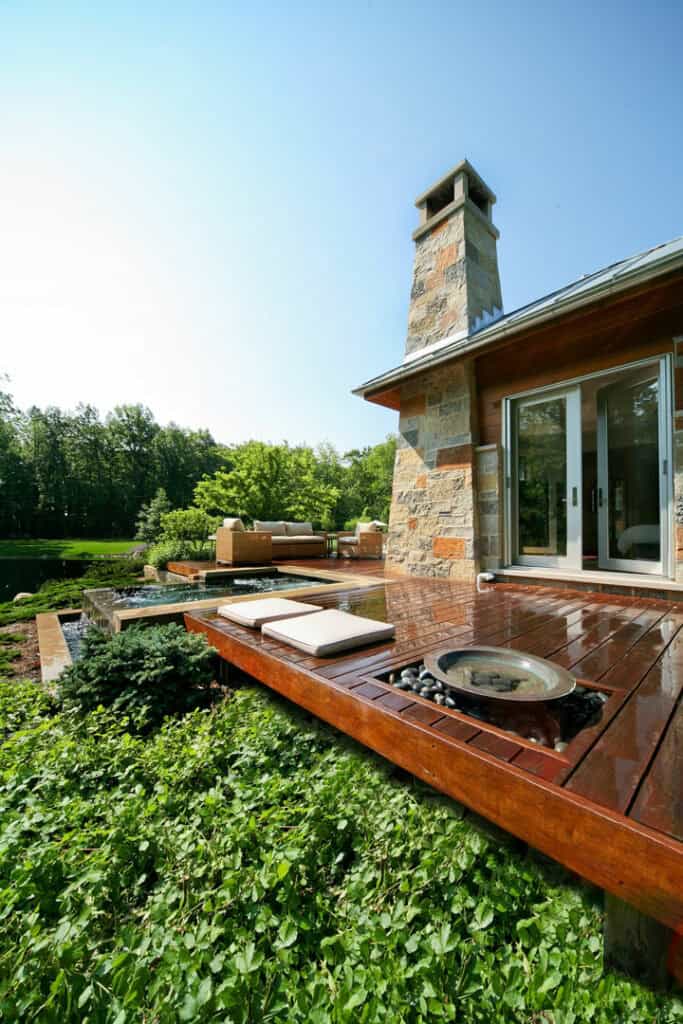
Landscapes Design Enhances Outdoor Spaces
Where architecture extends beyond the building
Architecture does not end at the building’s edge, it extends into the landscape of the surrounding site and views beyond. Landscaping is more than planting flowers or laying a patio. It enriches the experience of home with a connection between indoor and outdoor spaces. Through the creation of these “outdoor rooms”, the landscape will frame the home it surrounds and mirror the comfort, style, and purpose of a home’s interior, creating a cohesive narrative between structure and surroundings.
The foundation of any strong landscape design lies in four essential elements: terrain, hardscape, softscape, and wellness. The terrain is defined by the natural contours of the land and interpreting how they might influence the design. Hardscape organizes the spatial flow with built features like patios, retaining walls, and pathways that add structure and durability. Softscape provides relief to the built form through trees, shrubs, and plantings that bring texture and shape to how the property feels. Lastly, wellness ensures the landscape nurtures a sense of peace, privacy, and connection to nature. When balanced thoughtfully, these components enhance the architecture, complete the yard, and elevate the homeowner’s daily experience.
Want to experience more! Click on the images!
Terrain – Natural Elements of the Site

Successful landscaping begins with an understanding of the site’s natural elements. The shape, topography and drainage of the land – whether it’s steep, rocky, terraced, or flat – greatly influence how the outdoor spaces are designed and used.
Drawing inspiration from the site itself, the natural contours guide the architectural and landscape response. For example, in the “Stepping House,” the building adapts to the elevation changes, working in harmony with the landscape to enhance the visual connection between the home and its surroundings.
Proper grading and the integration of designed features like slopes, terraces, rain gardens and dry creek beds effectively manage drainage. Root systems from plants and ground cover hold soil in place, preventing erosion from wind and rain. Landforms are sculpted to support patios, stairways, and planter boxes to further enhance the site, creating beautiful, functional, and sustainable outdoor spaces.
Hardscape – Defining Outdoor Rooms

Hardscape elements define the structure, circulation, and purpose of the site, shaping outdoor living areas and transforming the land into inviting, usable space.
At the “Modern European Residence,” raised terraces for dining and conversation are surrounded by garden beds, which add perimeter definition to these natural extensions of interior living areas. Pathways, steps, and retaining walls establish flow and organization, while features like pergolas, fireplaces, and garden follies introduce rhythm and focal points to the design. Integrated landscape lighting enhances aesthetics and safety, highlighting the overall design into the evening hours.
Whether it’s gaming on the sports court for active recreation or a quiet moment on the seating wall, hardscape is essential in crafting outdoor rooms that reflect how homeowners live, relax, and connect with nature.

Softscape – Vegetation Eases the Edges

Softscape elements bring life, beauty, and balance to landscapes, softening the built structures and creating a more immersive natural experience.
Layering the softscape components creates a visual harmony through a hierarchy of trees, shrubs, plantings, ground cover, mulch, and flowers, and establishes depth, color, and texture. Trees offer shade and help regulate temperature, while native plants and flowers, chosen for their compatibility with local sun, soil, and drainage conditions, provide seasonal variation and may reduce maintenance. Ground covers and rain gardens manage stormwater runoff and minimize erosion.
A blending of plant life doesn’t just enhance aesthetics, it helps a home feel rooted in its environment, allowing residents to live with the land, not just on it, echoing Frank Lloyd Wright’s philosophy of harmony between nature and architecture.

Wellness – Calming in Nature

Landscaping has a profound impact on health and wellness through a connection to nature, creating a sense of peace in spaces that nurture the mind, body and soul.
Outdoor design is not only for beauty and function but also to support a sense of well-being. When collaborating with our landscape experts, a variety of outdoor areas are thoughtfully planned to support the homeowners in their quest to unwind, connect and recharge.
Green spaces are proven to reduce stress, promote relaxation, and encourage physical activity, whether through a simple stroll in the garden or a swim in a private pool. Water features such as ponds and fountains provide soothing soundscapes and calming visual focal points. Small decks or green grass areas serve as settings for yoga, meditation, or quiet reflection. Nature bathing, integrating landscaping into everyday life, transforms outdoor areas into restorative environments that engage all five senses and elevate overall wellness, creating a peaceful preserve at home.

Architecture & Interiors
Extending to the Outdoors